|
Need Acrobat Reader for PDF documents?
|
My year with a car almost exactly like
this
(and my life with many others)
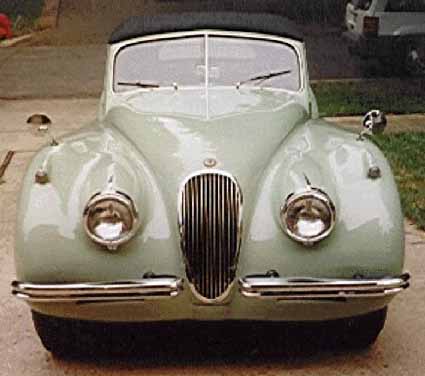
In 1964, when I was 21, I bought a white 1953
Jaguar XK120 drophead coupť almost exactly like this one for £150.
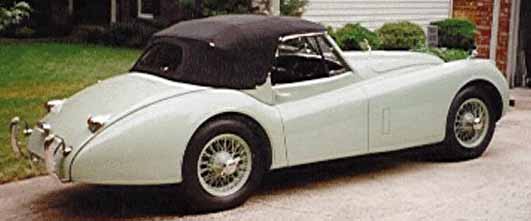
At the time I was living in a £5-a-week flat on the
edge of Hampstead in London. I had just moved from a job at £850 a year to
one at £1250 a year, clearing the then magic thousand-a-year barrier with
room to spare. A colleague in the advertising agency offered me the Jag
for £150. I was feeling rich and I couldnít resist it. After all, this
was the Sixties!
An insurance broker friend of my Dad managed to get
me insured at a premium I could afford - me, a 21-year-old, in a Jag
sports car. Crazy.
The day I bought the car I spent the whole
afternoon pottering nervously around the back streets before I dared take
it out in traffic. The fastest thing Iíd driven ítill then was my bossís
Standard Vanguard (huge, heavy and 2 litres), and the Jag was very
frightening . When I blipped the throttle, the whole car tilted sideways
because the rotating parts of the 3.4-litre dohc six-cylinder engine were
quite heavy relative to the light aluminium body (thatís right - no rust).
And, when I floored it in any gear except top, the mile-long bonnet rose
alarmingly in front of me, brandishing its leaping-jaguar mascot (missing
from the car in the picture).
Then I found out about the catches. The car wasnít
taxed and didnít have an MoT. I put it in for its MoT and it failed on
several things. Mostly, it failed on the brake master-cylinder, and I
couldnít even afford a second-hand one. So I drove the car on dodgy brakes
with no MoT and no Road Tax for a year - and got away with it.
The tyres were old-style Michelin Xís with not much
tread left. They were lethal in the wet, with 160 bhp on the rear wheels.
My fondest memory is of Boxing Day morning, 1964.
Iíd spent Christmas Day at my parentsí house, 15 miles west of London, and
I had to meet an old girlfriend off a train at London Victoria. It was
frosty, clear and sunny. I had the top down and was wearing my duffel
coat, my woolly hat and my strinbgback gloves - so cool .
As I drove onto the A40 roundabout in third gear,
the big exhausts burbling behind me, a Mini Cooper S - then the trendiest
car in Britain - cut in front of me at high speed and howled off along the
dual carriageway. íCheeky ******!í I said. I dropped the stubby lever into
second and floored the throttle. The XK roared and reared.
At about the time I changed up into third I passed
the Mini. I kept accelerating through third and fourth (in those days even
exotic sports cars had only four) along the straight stretch of dual
carriageway that ran across the old Northolt aerodrome. When I finally
decided it was time to slow down for the next roundabout, the speedometer
was reading over 130 mph.
I ran the car for a year, illegally on almost all
counts, and when I couldnít afford to re-insure it I sold it to a friend
at work for just £90.
I found these pictures on the Web recently. This
could easily be my £90 car, fully restored. VIP
Classics of San Diego, California, had it for sale in
February 1999 - at $68,950 ! Have a look at their
mouthwatering site.(Many thanks to Roy Sayles, President, for permission
to use the photographs.)
Hereís the engine. Isnít it just beautiful?
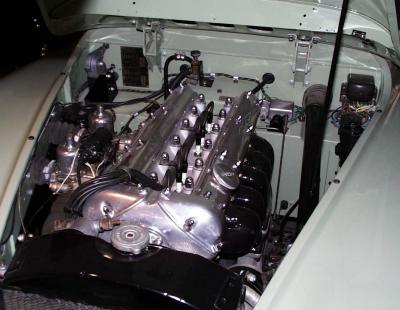
I found plenty of other information about the model
on the Web, including a
1949 test report on the original roadster version from The
Motor. Like me 15 years later, the tester was awestruck by the
XK120ís 126mph top speed and 10-second 0-60mph time.
Airbrush drawings from the original 1953
US brochure
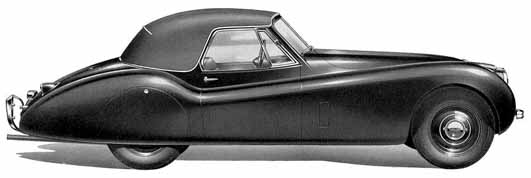
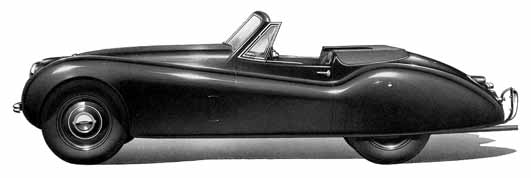
Many thanks to the Jaguar
Cars Historical Brochure Homepage for publishing this, the
Motor road-test and so much other historic Jaguar literature.
The trouble with information is that it sometimes
shatters illusions. I was really upset - as well as amazed - to learn that
the ordinary 2.0 Ford Mondeo Si, which I drove from 1997 until March 2003
and which did 129mph and 0-60mph in 9.2 seconds, was faster all round than
my beloved Jag.
It was a lot less sexy, though!
And my other cars...?
I passed my driving test (at the first attempt, but
by the skin of my teeth, according to the intimidating Welsh examiner) on
the 18 May 1960, four months to the day after my seventeenth birthday.
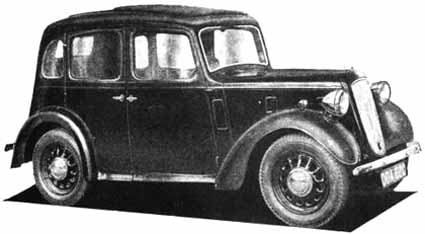
- When I started work at 18, I bought a 1937 Austin
Big Seven like the one above for £10. It was black, but I suspect they
only made them in black. It had a 900cc engine and a heavy four-door
saloon body, but the running gear was the same as on the much-lighter
750cc two-door car. This put huge strain on the half-shafts, and I think
I must have bought every half-shaft in every breakerís yard in West
Middlesex before I finally got fed up with replacing them (which
involved taking the whole back axle off and splitting it.)
- £15 bought me a 1936 Humber Super Twelve - a real
luxury car by pre-war standards, but still with no heater. This carís
eccentricity was the habit of dropping valve cotters, leaving me limping
along on three cylinders with flames belching out of the carburetter.
- Then came the Jag.
- The next car was a lot later - a 1958 Wolseley
1500 which someone had brush-painted in Champagne and Burgundy. That got
us from London to Cornwall for my college interview, back again, and
then down to Cornwall again when we finally moved. It lasted through my
two-year college course, but eventually rust got the better of it. I
fibreglassed the whole of one side, turned it round, jacked it up to
work on the other side - and the whole rear suspension fell off!
- Then came a smashing little Morris 1000, which
lasted through the end of my first marriage and into the relationship
that became my second. It was still going strong when my Dad persuaded
us to change to the next car, and I actually managed to sell it.
- My Dad had started driving again at the age of 70
after letting his licence lapse after World War 2, and he opted for an
automatic. Not just any automatic, but a Daf 44 estate with the amazing
Variomatic transmission. This used rubber vee-belts and variable pulleys
to give a continuously variable gear ratio - bizarre, but it worked
wonderfully. After we bought it from him, the little air-cooled 850cc
twin took us all the way from Cornwall to the North of Scotland and
back, going over Hard Knott Pass in the Lake District en route (with two
adults, one child, full luggage and camping kit), and cruising happily
at 85 on the motorways.
- Then we bought a Ford Transit Dormobile, which did
several more holidays in the Highlands.
- When the Transit was on its last legs, my Dad gave
up driving and presented Wife Number Two with his second Daf 44, a
saloon, which took over where the van left off.
- A neighbour persuaded me to buy a Rover SD1 3500
from a garage he knew. I didnít take much persuading - by my standards
this was a truly awesome car (despite its tendency to rust, which kept
my out on the pavement with my fibreglassing skills for many hours).
Then, on the way back from Easter Sunday Lunch at a local country pub,
some dickhead spun a Metro on a sprinkle of snow and put one corner of
it through the Roverís radiator (the Metro ended up much more seriously
bent). Because it was an old car, the insurance company wrote it off. I
was heartbroken.
- With the insurance settlement I bought a 2.8 Ford
Granda GL, which served us well on several more Scottish jaunts (in
spite of the fact that I could never stop it pinking - a session with a
HomeTune expert revealed that the two banks of the V6 engine had
drastically different compression ratios, so it could never have run
properly since new - surprising, since it had been a Rolls Royce company
car!
- Then, thanks to a Derbyshire County Council
low-interest loan, came my first brand-new car. This time I wasnít
fooling around - it was a 1.9 litre Peugeot 205 GTI with 130bhp under my
right foot, the best of the hot hatchbacks at the time. I adored it, but
it was too small and too badly ventilated for our first European holiday
(see The
Big Holiday).
- So I extended my County loan and bought a brand
new CitroŽn BX GTI - with air-conditioning. Excellent car. I canít
remember why I changed it...
- The third - and last - new car was a CitroŽn ZX
Aura estate with the amazing CitroŽn/Peugeot 1.9 turbo-diesel. That was
great - roomy, practical, quick and very likeable - but the suppliers
had had third-party air-conditioning fitted for me, and that was a
disaster. It broke down when the car had been parked in full sun for
several hours at Les Saintes Maries de la Mer, on the coast of the
Camargue in Provence. Bad news - that was a hot holiday! I never got it
fixed to my satisfaction. Then I had the only serious accident I have
ever had (the Rover write-off was only serious for the Metro and my
pocket): I lost concentration when very tired one night on the M6 near
Carlisle, spun it and slammed both ends in turn into a crash
barrier. After that, with the air-con still causing trouble, I
ípersuadedí the agents to buy it back at top book price - and refund the
£1400 extra Iíd paid for the air-con (I can still remember storming out
of the Managing Directorís office with my own words - íSee you in
Court!í echoing in my ears!).
- I bought a 1.7-litre petrol Peugeot 405 GL saloon
with the proceeds, but it was underpowered and a rubbish load-carrier,
so I part-exchanged it for...
- A Ford Mondeo Si Hatchback - not underpowered at
all and a serious work-horse, with superb sports seats, as well as a
lovely drive. It had a big boot which became absolutely vast when the
back seats were lowered
- When I started my job with the NHS, Pat and I
bought a Mondeo Ghia Estate as a second car - also a beauty, with an
absolutely vast loadspace.
- In 2003 we traded it in for a 2000 W-reg Peugeot
406 Executive Estate - much nicer from the rear than the saloon. It was
a quiet, superbly comfortable long-range tourer and a remarkably
economical everyday runabout, as well as doubling as a van with the back
seats down: it would easily take two of those huge bags they sell sand
and gravel in, packed so full of garden refuse that I could only just
lift them into the back. Ours had the extraordinary 110bhp HDI diesel
engine, and with 105,000 miles on the clock it ran more smoothly than
when we bought it with 40,000 - the guys at the independent
Peugeot/Citroen garage that used to service it for us in Derby told me
that the Asian taxi drivers loved this car but wouldnít touch one until
it had topped 100,000. With amazing poke for its size, weight and
fuel-preference (I didnít dare compare the performance with the Jagís -
it would really have shattered the illusion to find that the XK120 was
outrun by a French diesel estate!), and nimble, sure-footed handling, it
was a definite step up from even the sporty Mondeo Si. With full black
leather upholstery and trim, a superb automatic air-con system, a six-CD
changer in the boot and a trip-computer that made driving for economy
really fun, it was quite a luxurious drive (even with half the garden in
the back). It was also ridiculously economical - the computer settled at
47.1 mpg for a period of over 6000 miles, and stayed there even after
taking a huge kitchen table to Normandy on the roof! Considering tha,
because we were going to France so often, I left our vast roof-box on
(great for finding your car in huge car-parks), that was pretty amazing.
With a full tank costing the wrong side of £75, it was consoling to
think how long it would be before the next fill-up as I handed over my
credit card.
May 2008 - goodbye Peugeot and hello Audi
As the Peugeotís odometer was homing in on 108,000 miles, it had had
a few bangs and scrapes (mostly not our fault) and it had recently needed
a succession of expensive repairs, we decided reluctantly that it was time
for a change.
For some reason I had developed a yen to road-test an Audi diesel
estate - the A4 or the big A6. I used to hate the bullying look of these
beefy Germans, but something had mysteriously changed my view. However, I
thought it might be worth looking at the other top-notch Germans as well,
so I spent a couple of days on the Audi, Mercedes and BMW websites,
looking at their íApprovedí used cars. Then we visited the Audi garage in
Sheffield to road-test a 1.9TDI A4 Avant (thatís what they call their
estates). It took only a short test-drvie to decide that the A4 was too
small - not enough legroom in the back, not enough space in the boot and a
nasty hard side to the central console against which my left knee insisted
on pressing quite painfully while driving.
A pity, because this car had a íMultitronicí transmission, which
turned out to be an update on the DAF Variomatic I described further up
the list. Audiís version uses a segmented steel belt instead of the DAFís
rubber vee-belts, and undoubtedly has masses of electronics instead of
DAFís beautifully simple balance of cenrifugal force and manifold vacuum,
but then it can cope with a 450bhp V8 driving a huge MPV. The experience
clicked a long-unused switch in my head and I adapted immediately to the
seamless changes in ratio (if you prefer seams, you can put it in sports
mode, which gives you the effect of a 7-speed sequential gearbox like they
have in F1 cars - the bigger Audis even have a paddle-shift for this). Iíd
have loved a car with this transmission. But not this one.
The salesman told us that he didnít have an A6 Avant for us to drive
at the moment, but one was being prepared in the Chesterfield workshop and
there was a better one in York which he could bring down. Both had the
1.9-litre TDI, which develops 130bhp - 20 more than our 2-litre Peugeot.
Read that paragraph again and then go back to the bit about the
Peugeot 205 GTI. Yes, that had 130bhp - and so does the Audi turbo-diesel
with the same size engine. Amazing, isnít it...?
Meanwhile, our salesman said, heíd like to show us something a bit
unusual. This was basically an A6 estate too, but it had the 2.5-litre
170bhp V6 turbo-diesel, Audiís legendary rally-bred Quattro permanent
four-wheel drive and air suspension that could be set to four different
ride-heights, making it a strange hybrid of family estate and SUV. It was
called the Allroad. It had a satnav integrated with the audio system, with
everything visible on a 5-inch colour LCD display and driving instructions
coming through the audioís speakers. These speakers and their amplifier
were by Bose (and would have cost the original buyer nearly £1000 extra).
There were acoustic parking sensors front and rear. A 6-disc CD change in
the boot... Beautiful, we said, but way too far over our budget. And far
too many things to go expensively wrong...
Have a drive, anyway, he said. And I did, And it was wonderfully
smooth and quiet - and fast.
Then we waited for the íniceí A6 Avant to come down from York, but it
turned out that it hadnít been fully prepared and needed new brakes. We
could look at it and drive one which he didnít think weíd like, just to
assess the engine. We did. The 130bhp diesel was easily powerful enough
for this big estate, and offered overall consumption of 48mpg - about the
same as the 406. The nicer one, which I wasnít allowed to drive because of
the brakes, was comfortable, well-equipped - and bland. The interior
seemed bleak compared with the 406ís.
So we got out, and went and had another look at the Allroad (overall
consumption in the mid-30s, we were told), and argued that it was too
expensive to buy (four grand more than the other car) and would be too
expensive to run (especially with the cost of diesel spiralling upwards).
And what about the carbon footprint? But it was a lovely shade of
greeny-grey (the other one, like so many Audis, was black), with lots of
subtle trim changes that made it look quite unlike an ordinary A6 Avant,
and it was a stunning drive, and...and...and...
And we bought it. After all, at 65 and 63 this might well be the last
car we would ever buy. And I havenít bought a silly one since the 205 GTI.
So sod it!
After two round trips to Sheffield weíd managed to keep the
consumption on the right side of 35mpg. As our daughter-in-law helpfully
pointed out, her 4-litre Jeep Cherokeeís average mpg frequently dropped to
13.
The price had been dropped three grand to the garageís absolute
minimum, so we could always sell it privately if we decide it wasnít such
a good idea. Somehow, though, I thught we might be keeping it...
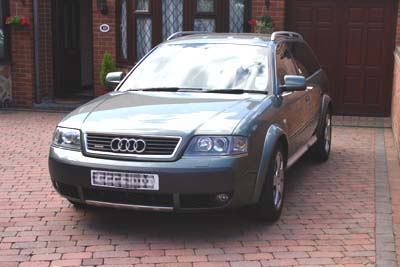
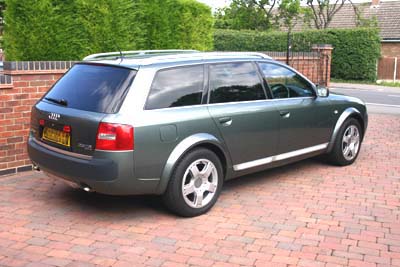
Update 9 June 2008 Weíve had the car for ten days now.
Itís a delight to drive after the poor old 406, and weíve managed to keep
the average consumption between 34 and 36mpg - no long-distance trips yet,
so it will be good to see how it goes with a few hundred high-speed miles
under its belt.
Update 16 June 2008 We took our grandson to The Deep,
Hullís wonderful aquarium, last week, going up mostly on minor roads and
returning on motorways, which gave me a chance to cruise at reasonable
speeds and also to give the car its head. The punch above 70mph was
amazing after the 406. But now, after more trips across to Sheffield, Iím
struggling to keep the mpg close to 34 - not too clever in these times of
inflated fuel prices. Question: diesel used to be cheaper than unleaded
here and about 30% cheaper in France; why is it now up to 15p a litre
dearer here and also much more expensive in France? The duty of petrol and
diesel in identical now - was that on diesel lower before? Surely itís
cheaper to make diesel than unleaded petrol - itís far less refined...?
Update 16 December 2008 Because of the
wretched knee, I havenít been able to drive since the end of July. Now
Iím almost ready to try the clutch - I canít wait. Patricia has managed to
get the fuel consumption up to around 32 mpg, so itíll be interesting to
see if I can get it down a bit... One disappointment is that the
5-year-old satnav isnít a patch on the Garmin I bought a year or two ago,
so I think we might go back to that.
Update 24 May 2011 Three years on and we still have
the Allroad. And we still love it. The long-term average fuel consumption
is between 31 and 32 miles per gallon, which is pretty dire, but the car
hasnít sprung any nasty surprises on us. I was pretty hacked off when it
turned out not to have a full yearís MoT, and then came up for a timing
belt change less than 10,000 miles after buying it, though, and then
routine replacement of the rear discs and pads. Iíd fallen for the
Audi-approved blurb - but I should have read the small print. We keep
saying we ought to swop it for something more economical, but somehow we
never really convince ourselves. Itís so lovely to drive, even if the 2003
Audi satnav is a pain in the neck compared with the little Garmin I bought
in about 2007.
Update 1 May 2012 The Audi is still with us. It has
just romped through its MoT without a hiccup. Although I keep pondering
alternatives, because the long-term consumption seems to have settled to
33.2 miles per gallon and the cost of fuel is getting really silly, I
haven?t even gone so far as to buy a Parker?s price guide. If we do
eventually decide on a change, my favourite would be a BMW ?Touring?
(estate) - a 520D or a 320D. But the Allroad is so nice...
June 2013
A year on from the last update, we finally faced the necessity of
economising on several fronts: gas, electricity, telephone, broadband
(which amazingly took us onto BTís Infinity fibre-optic system), car
insurance (goodbye Co-op, hello Post Office) and finally the car itself.
The Allroad was about to start costing some serious money - a new set of
tyres (the last set cost about £700!), new rear brake discs and drums and
the tracing and repair of a mysterious leak that put a puddle into the
front passenger footwell whenever it rained heavity. Time for a change: a
smaller car with much better fuel consumption, lower Road Tax and (I
thought) cheaper insurance.
A few weeksí research took us down to a VW Golf or (my preference) a
Ford Focus. Iíve never seen so many really favourable write-ups on a car
from so many reviewers whose main job is to find faults - the Focus seemed
almost two good to be true. I really wanted the Titanium spec, but we
ended up with the Ghia - a 2006 1.8 TDCI (115bhp - only 15 less than my
205 1.9 GTI), which cost us the Audi plus just under £2000. Or just over,
by the time weíd had rear parking sensors fitted and bought a one-year
warranty.
As I write (28 June), itís three days since I waved goodbye to the
beloved Allroad and brought the focus home. I havenít been far in it yet,
but a trip to town returned an average consumption just over 43 mpg
(compared with the Audiís 33 after plenty of long-distance running). It
drives beautifully - firm and sporty, with lots less roll. Obviously a bit
noisier than the smooth and nearly silent V6 Audi, but quite bearable. I
can see why so many people love this model. Even our Ringtonís tea guy
told me heís got a y-reg Zetec - had it for years and can see no reason to
change it. The only disappointment is that the insurance is actually
more expensive because itís a newer car - back to
Compare-the-Meerkat next year!
Iíll write more when weíve done a bit more driving and got to know
the car properly.
|
Personal site for Paul Marsden: frustrated writer;
experimental cook and all-round foodie; amateur
wine-importer; former copywriter and press-officer; former
teacher, teacher-trainer, educational software developer
and documenter; still a professional web-developer but
mostly retired.
This site was transferred in June 2005 to the Sites4Doctors
Site Management System, and has been developed and
maintained there ever since.
|








